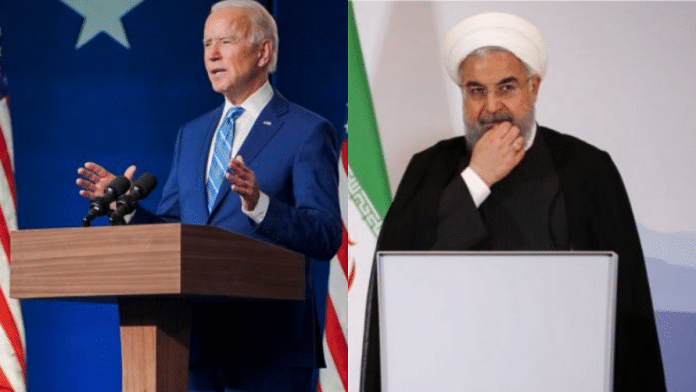On Thursday, US strike-fighters launched a cluster of precision-guided bombs against a crossroads infrastructure complex in eastern Syria used by Iranian-backed militias. The strike reportedly killed at least one militia member and possibly more than 20, wounded others, and included the use of seven 500-pound Joint Direct Attack Munition weapons.
It was a moderate choice by President Joe Biden in terms of the level of force, and was clearly intended to send a signal to Iran, rather than to inflict serious damage and casualties.
The attack represented a justifiable and appropriate military response to recent rocket attacks against bases in Iraq, where U.S. and allied troops worked alongside civilian contractors training Iraqi military forces. Those strikes killed a contractor and injured at least one U.S. service member.
Broadly speaking, all this could be considered part of the cycle of escalation that began with the assassination last January of General Qassem Soleimani — who had directed many strikes that killed U.S troops in the region. You reap what you sow in the end, I suppose.
John Kirby, the Pentagon spokesman, said the strikes were “authorized in response to recent attacks against American and coalition personnel in Iraq and to ongoing threats to those personnel.” He went on to say: “This proportionate military response was conducted together with diplomatic measures, including consultation with coalition partners. The operation sends an unambiguous message: President Biden will act to protect American and Coalition personnel. At the same time, we have acted in a deliberate manner that aims to de-escalate the overall situation in both eastern Syria and Iraq.”
What is the thinking behind the U.S. attack, and will it in fact “de-escalate” the confrontation with Iran?
Also read: Why Biden’s military strike in Syria should wake up Iran
I’ve ordered many strikes as a commander over the course of my years in the Navy, but one stands out. It was in the late summer of 1998, against al-Qaeda training camps in Pakistan, when I was sea combat commander in the Lincoln carrier strike group. The attack was retaliation for the bombings of U.S. embassies in eastern Africa. While the Tomahawk missiles hit their intended target, they missed killing important Qaeda leaders. On Sept. 11, 2001, we heard from Qaeda again, and I narrowly missed being killed by the attack on the Pentagon that struck close to my office on the side of the building hit by the airliner.
The strike that the forces under my command launched in 1998 — like the one undertaken Thursday in Syria — was proportional, sensible, well executed and necessary to demonstrate that we would not tolerate attacks against U.S. personnel serving overseas. Yet it did not deter Qaeda, and if anything it spurred the terrorist group to further action, culminating in the 9/11 attacks. Unfortunately, as a general proposition in international relations, one attack often leads to another.
The Iranians have been climbing the ladder of escalation briskly. They have launched or sponsored drone strikes against Saudi oilfields; supported Houthi rebels in Yemen who have conducted long-range missile attacks against Riyadh; seized commercial tankers, including a South Korean vessel they still hold; and encouraged their Shiite militias in Syria and Iraq to attack U.S. facilities.
They continue to lash out because they are under crippling sanctions and desperately want to get out from under them. All of this is exacerbated by internal domestic political pressure in Tehran generated by the nationwide elections scheduled for June.
The Biden team is not unfamiliar with the use of force in the Middle East. The secretary of Defense, retired General Lloyd Austin, headed U.S. Central Command over a period in which the Pentagon mounted countless strikes. Secretary of State Antony Blinken saw both sides of the military/diplomacy equation in the Barack Obama administration, first as national security adviser to then Vice President Biden, and later as deputy secretary of State. And as Obama’s vice president, Biden was in place for many discussions about the use of force from Libya to Syria to the raid that killed Osama bin Laden. They are neither naive about the impact of such a strike, nor overly optimistic as to its long-term outcome.
What should be clear, both from the Iranian attacks on U.S. bases and this modest response, is that the path ahead with Iran will be complex and fraught. Kirby, a retired admiral and one of the most experienced and capable spokesmen ever to take the Pentagon podium, said all the right words: “proportionate,” “consultation with coalition partners” and “unambiguous message.” The signal being sent is simple: Stop the bad behavior and let’s start talking.
But we must be clear-eyed that this strike may lead to further violence, especially from the militia groups — which exist to give Iran deniability for events from Lebanon to Yemen. The Iranians still feel they have uncollected bills in terms of revenge for the killing of Soleimani.
The coming elections create an opportunity for the hardline side of their political spectrum. And the Iranians have plenty of options, including strikes against Saudi Arabia, Israel, and U.S. and coalition troops.
The best outcome is that Iran will observe U.S. determination and return to the negotiating table under the auspices of the talks proposed by America’s European allies. The Biden team has done the right thing in consolidating the Western alignment among the U.S., the European Union, France, Germany and the U.K. Their vision seems to be getting all parties back to the table; offering some minimal level of sanctions relief; building on the bones of the 2015 nuclear deal to create a more sweeping agreement; and limiting Iranian ballistic missiles, terrorist activity and weapons of mass destruction.
It is a big vision, and getting past the tit-for-tat violence is only the first step. Let’s hope the Iranians are in the mood to listen. – Bloomberg
Also read: Joe Biden protected US personnel, deterred risk of attacks through Syria air strikes — White House



